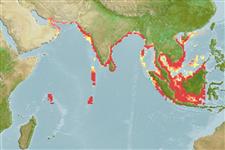Common names from other countries
Environment: milieu / climate zone / depth range / distribution range
Sinh thái học
Biển; Thuộc về nước lợ; sống cả ở nước ngọt và nuớc mặn (Ref. 51243). Tropical; 29°N - 8°S, 55°E - 118°E (Ref. 188)
Indo-West Pacific: in tropical waters, from the Gulf of Oman to at least Madras, perhaps to the north and along the coasts of Myanmar, certainly at Penang, to the Java Sea, and Gulf of Thailand.
Bộ gần gũi / Khối lượng (Trọng lượng) / Age
Maturity: Lm ? range ? - ? cm
Max length : 23.0 cm TL con đực/không giới tính; (Ref. 122100); Khối lượng cực đại được công bố: 87.00 g (Ref. 122100)
Các tia vây lưng cứng (tổng cộng) : 0; Tia cứng vây hậu môn: 0; Tia mềm vây hậu môn: 51 - 63. Belly convex in front, with 29 to 35 scutes. Mouth pointing obliquely upward; lower gill rakers 22 to 28, increasing with size of fish. Pectoral fin usually about equal to head length or greater; dorsal fin small, well behind midpoint of body; anal fin long, its origin well before dorsal fin origin.
Found close to shore and also entering estuaries (e.g. Aluhaluh on Barito River in Kalimantan, Indonesia). Ascends rivers into the tidal zone (Ref. 12693). Feeds on mysids, Pseudodiaptomus and copepod eggs, also prawns and other small crustaceans, bivalve eggs and larvae, amphipods and small fishes. Spawns in late February or early March to July or August (around Karwar, India). Used as fish meal or fertilizer (Ref. 4832).
Life cycle and mating behavior
Maturities | Sự tái sinh sản | Spawnings | Egg(s) | Fecundities | Ấu trùng
Whitehead, P.J.P., 1985. FAO Species Catalogue. Vol. 7. Clupeoid fishes of the world (suborder Clupeoidei). An annotated and illustrated catalogue of the herrings, sardines, pilchards, sprats, shads, anchovies and wolf-herrings. FAO Fish. Synop. 125(7/1):1-303. Rome: FAO. (Ref. 188)
IUCN Red List Status (Ref. 130435)
CITES (Ref. 128078)
Not Evaluated
Threat to humans
Harmless
Human uses
Các nghề cá: buôn bán nhỏ
Các công cụ
Special reports
Download XML
Các nguồn internet
Estimates based on models
Preferred temperature (Ref.
115969): 26.8 - 29.3, mean 28.6 (based on 676 cells).
Phylogenetic diversity index (Ref.
82804): PD
50 = 0.5156 [Uniqueness, from 0.5 = low to 2.0 = high].
Bayesian length-weight: a=0.00724 (0.00474 - 0.01106), b=3.04 (2.92 - 3.16), in cm Total Length, based on LWR estimates for this species & (Sub)family-body (Ref.
93245).
Mức dinh dưỡng (Ref.
69278): 3.4 ±0.46 se; based on food items.
Thích nghi nhanh (Ref.
120179): Chiêù cao, thời gian nhân đôi của chủng quần tối thiểu là dưới 15 tháng (Preliminary K or Fecundity.).
Fishing Vulnerability (Ref.
59153): Low vulnerability (13 of 100).
